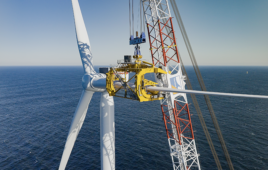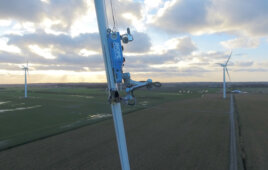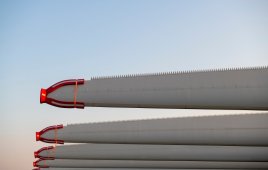Leading-edge erosion is a major cause of wind turbine blade wear. As the turbine rotor spins in the air, it hits dust, dirt, insects, hail, and more. That does not sound like much until you consider the blade tip could be spinning over 100 mph. Once the blade edge wears, water can invade, freeze, and eventually ruin the structure’s aerodynamics.
To appreciate the speed of a blade, use these equations to figure tip speed and then other curious information regarding rotor dynamics.
Speed, S, is simply a change in distance over a change in time. Miles per hour, or mph in North America, is the most common unit. The equation looks like this:
S = d/t
To find tip speed, we need the rotor diameter and rotational rate. So assume a rotor diameter of 100m and a rotation rate (ω) of 15 revolutions/min, rpm.
Distance in this case is the circumference C of the rotor’s circle, which is found with:
C = πD
Where D = diameter in meters, m
So our 100m rotor describes a circumference of:
C = π x 100m
= 314m, therefore
S = 314m x 15 rotation/minute
= 4,710 m/min
A Google search says to convert m/min to mph, multiply by 0.0372 [mph / m/min].
Hence,
Smph = 4,710 m/min x 0.0372
= 175 mph.
That’s fairly fast. Many light planes cannot reach that speed. So a full equation for tip speed in mph with the rotor diameter in meters, m, because that is the most common unit to describe rotor diameters, would be
Smph = πDω x 0.0372 (1)
Now let’s ask: How far from the hub is the 100 mph mark?
The answer is in solving equation (1) for the diameter, D, and setting S = 100 mph, like this:
D = Smph /(π ω x 0.0372)
= 100 mph / (3.14 x 15 rev/min x 0.0372)
= 57m diameter mark
Or 28.5m measured from the hub center to a point on a blade. You can see that almost half the rotor is in a 100-mph” zone”. You can solve equation (1) for ω as well:
ω = Smph /(πD x 0.0372)
With this you can ask: What rotational speed on the 100m rotor is needed for a tip speed of 200 mph?
ω = 200 mph / (π 100m x 0.0372)
= 17.1 rpm. In high winds, that could happen.
Questions, comments, and corrections are always welcome. –Paul Dvorak
Filed Under: Blades





Rotor diameter = 12”
From center of rotor to outer tip of blade is 10’
Center speed of shaft is 12,000 rpm
What is the outer tip speed?
Can you please help me to calculate how many rotations per minute has a wind turbine, taking into consideration that I only have the following info:
– diameter
– height
– blade length
– wind speed
– wind class
– cut-in speed
– cut-out speed
There’s got to be a formula, but I was not able to find it…
Thank you!
Ken and Hossam:
Thanks for your good questions. I will look into the relationships and report on the findings.
Paul Dvorak
Is it possible to predict the maximum power output from the blade tip speed?
Hello,
the paper is remarkable and so valuable,but,
what is the relation between the blade tip speed and the turbine capacity.?